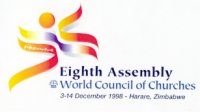
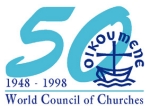
No. 1
 |
WCC Anniversary and Eighth Assembly |
 |
|
Feature
Service No. 1 | ||
Click to different language versions of
this text en
français en
français auf
Deutsch auf
Deutsch en
espanol en
espanol |
Happy Birthday WCC by Marlin VanElderen
|
|
Information for editors and
journalists Here is the first in a series of monthly articles we shall provide in 1998 to mark the WCC's 50th anniversary and prepare for the Eighth Assembly in Harare, Zimbabwe, 3-14 December 1998. Each month an article will focus on one aspect of the life of the WCC and the year's celebrations and assembly. This first article is by Marlin VanElderen. He is available for further comment and interview. Radio journalists please note that we have an ISDN line installed in our radio studio using a CCS Codec M66I 64K. Use of this article must credit the author. Editors may shorten the article, but this should be acknowledged. Please send us a copy of anything you publish for our records. Thank you. Good quality reproductions of the photos accompanying this text (see list below) are available via Internet or ordinary mail. To order a photo via Internet, just click on the photo of your choice. That takes you to our Photo Oikoumene homepage. There you click on the appropriate theme in the Photo Oikoumene index. When you have located your photo, complete the online order form. Photo Oikoumene will send the photo electronically as an attached file, at 300dpi resolution, JPEG format. If you want a colour slide, or colour or b/w photo by ordinary mail, send an E-mail inquiry to photo
Orthodox, New Delhi
(Theme: Evanston to New Delhi) (Ref. no.: 4170-14) Use of the photos with this article is free of charge; other use will attract the usual WCC fees. Please also feel free to download the Assembly and 50th anniversary logos and the "Highlights - 20th-century ecumenical movement" chart directly from this page. 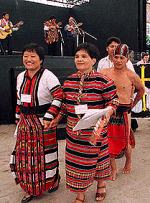 "Called to one hope - the Gospel in diverse cultures" was the theme of the WCC's conference on mission and evangelism in Salvador de Bahia, Brazil, in 1996 (Photo Oikoumene theme: Canberra to Harare; ref. no.: 6709-30) 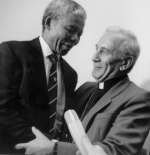 The-then WCC General Secretary Emilio Castro, leading the first WCC delegation to South Africa in 30 years, met with then-ANC leader Nelson Mandela soon after the latter's release from prison. (Photo Oikoumene theme: Canberra to Harare; ref. no.: 5309-31)  A tourist "must": a piece of the infamous Berlin wall. 1990 (Photo Oikoumene theme: Vancouver to Canberra; ref. no.: 4845-2) |
Founded in Amsterdam on 23 August 1948
by representatives from 147 churches, the World Council of Churches turns
50 this year. As delegates from its member churches prepare to mark this jubilee in December at the WCC's eighth assembly in Harare, Zimbabwe, what events and developments during the Council's first five decades have shaped its life?
Why was the WCC formed?
The WCC's constitution describes it as "a fellowship of
churches".
Over the centuries, the separate existence of these divided churches
has led to mutual suspicion, tension and sometimes even violent conflict.
Most of the time they have gone their own way, isolated from and
ignorant of each other.
The conviction grew in the late 19th and early 20th centuries that this
disunity contradicts the historic Christian confession that the church is
one and diminishes the credibility of Christian witness in a divided world.
The World Council of Churches was formed to call the churches to make
visible in the world the unity of his followers for which Jesus prayed
(John 17:21).
No super-church
The broad lines of the WCC's agenda are set by assemblies of delegates
from all member churches, which meet every seven years.
While each assembly has seen more churches represented than the
previous one - there are now 330 - the more significant growth has
come in the diversity of member churches. In 1948, two-thirds of them
were headquartered in Europe and North America; today, two-thirds
come from Africa, Asia, the Caribbean and Latin America, the Middle East
and the Pacific.
Diversity
While the largest church in the world, the Roman Catholic Church, kept its
distance from the WCC in the early years, the Second Vatican Council
(1962-65) made a clear commitment to seek unity with "separated
brothers and sisters".
In the years after the Uppsala assembly (1968), many people even
hoped the Catholic Church might become a WCC member. After long
discussions, this did not happen. But the WCC and the Catholic Church
do work closely together in many areas, especially through official
Catholic membership of the WCC's Faith and Order commission.
Most of the Council's founding churches came from the major historic
traditions of the Protestant Reformation - Anglican, Lutheran, Methodist,
Reformed and the like. But some churches from newer Christian
traditions have also joined. Among those to become members in New
Delhi were two Pentecostal churches in Chile. The first to join of several
independent churches in Africa (churches not originating in Western
missions) was the five-million-member Kimbanguist Church (Democratic
Republic of Congo), in 1969.
The Council has brought together the vision of three earlier movements
for church unity, which focused on (1) overcoming divisions in the
churches' missionary work, (2) examining their doctrinal differences
(Faith and Order) and (3) working together for a just and peaceful
society (Life and Work).
Major global meetings in these three areas have been milestones of the
WCC's first 50 years. They have been accompanied by numerous
studies drawing on the experience and wisdom of churches worldwide.
Mission
Much of its agenda was taken up by the WCC's fourth assembly in
Uppsala (1968), which responded to the revolutionary climate of the
1960s through commitments to an active - sometimes controversial -
engagement in social, economic and political issues which marked the
Council over the succeeding decades.
Of all those engagements - in development, education and health care, in
human rights, in the struggles of women, in work for disarmament and
peace - it was no doubt the Programme to Combat Racism which had the
highest profile.
Controversy
The controversy often overshadowed the credibility this involvement
earned the Council and its member churches among oppressed people in
many places.
Women
An expression of this concern has been the WCC's consistent emphasis
on the role of women in church and society (though the question of the
ordination of women continues to divide member churches).
Even before the 1948 Amsterdam assembly, the WCC commissioned an
international survey of the status of women in churches. In the 1970s
and 1980s, a further study on the Community of Women and Men in the
Church drew unprecedented local participation. And the Ecumenical Decade of
Churches in Solidarity with Women, which began at Easter 1988, will climax
with an international festival, also in Harare, just before this year's WCC
assembly.
Neither social action nor controversy was unknown to the
Council when the storms over PCR broke out in the 1970s and 1980s.
From the beginning the Council has insisted on holding together the
search for the unity of the church with the quest for the renewal of
humankind. And, as a worldwide organization, it has a significant role in
international affairs.
Even before its official founding, the WCC's Geneva office was a central
point. Through it, churches divided by the war maintained contact and
aided people fleeing Nazi persecution. Just after the war, the WCC
coordinated international church involvement in European resettlement
and reconstruction. Subsequently the Council played a major role in
interchurch aid, and each year channelled millions of dollars to respond
to disasters and to support development programmes in every part of the
world.
Cold War
A 1950 WCC statement supporting UN intervention in Korea led Chinese
member churches to withdraw from involvement in the Council until 1991.
And superpower rivalry often lay behind criticisms of the WCC's
outspoken support of the hopes and plans of the newly independent
countries from which a growing number of its member churches came.
Meanwhile, increasing participation in the WCC of church leaders from
Eastern and Central European socialist countries led to charges that the
Council was unconcerned about the persecution of "underground"
Christians in the Soviet Union. Indeed, critics accused the WCC of
supporting communism.
Many disputed the WCC's policy of relating officially to those churches in
communist countries whose leaders were allowed some freedom for contacts
and travel abroad, with the consequence that the Council's public stance
often looked unbalanced sharply critical of the West, silent or at best
muted in criticizing the East.
Others would argue that, for all its limits, this policy gave oppressed
churches an opening to the outside that eventually helped to bring about
the collapse of totalitarian governments.
In short, what does the vision of fellowship which has been at the
heart
of the WCC's search for unity over the past 50 years have to say to the
stark realities of the version of one world community fostered by today's
global economic, financial and media powers? That will be one of the
main questions on the agenda of the WCC's eighth assembly in Harare
later this year. How the world's churches answer will, to a large extent,
determine the degree to which the Council continues to provide a cutting
edge at the point where faith and life intersect.
|
Click here to: No super-church No super-church Diversity Diversity Keeping the vision alive Keeping the vision alive Mission Mission Faith and Order Faith and Order Life and Work Life and Work Controversy Controversy Women Women The churches in the world The churches in the world Cold War Cold War Future Future
First: 1948 Amsterdam, Netherlands, "Man's
Disorder and God's Design"
Second: 1954 Evanston, USA, "Christ - the Hope of the World"
Third: 1961 New Delhi, India, "Jesus Christ - the Light of the World"
Fourth: 1968 Uppsala, Sweden, "Behold, I Make All Things New"
Fifth: 1975 Nairobi, Kenya, "Jesus Christ Frees and Unites"
Sixth: 1983 Vancouver, Canada, "Jesus Christ - the Life of the World"
Seventh: 1991 Canberra, Australia, "Come, Holy Spirit - Renew the Whole
Creation"
Next WCC Assembly |
| Marlin VanElderen is Executive Editor, WCC Publications. He is author of "Introducing the World Council of Churches", and technical editor of "The Dictionary of the Ecumenical Movement" (WCC Publications 1991), a revised edition of which will be published in March 1998. | 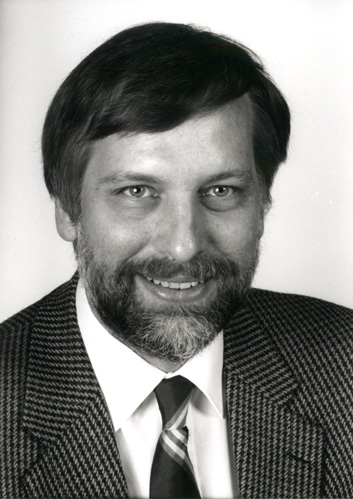 |
|
John Newbury Press & Information Officer P.O. Box 2100 CH-1211 Geneva 2 Tel.: (+41.22) 791 61 52/51 Fax: (+41.22) 798 13 46 E-mail: media |
 Feature Service list
Feature Service list 8th Assembly & 50th Anniversary homepage
8th Assembly & 50th Anniversary homepage Press Release list
Press Release list WCC homepage
WCC homepage |